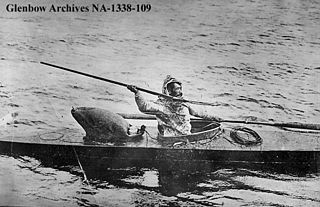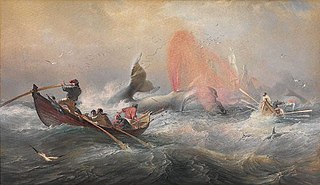
A harpoon is a long spear-like instrument and tool used in fishing, whaling, sealing, and other marine hunting to catch large fish or marine mammals such as whales. It accomplishes this task by impaling the target animal and securing it with barb or toggling claws, allowing the fishermen to use a rope or chain attached to the projectile to catch the animal. A harpoon can also be used as a weapon. Certain harpoons are made with different builds to perform better with the type of target being aimed at: the Inuit for example have short, fixed foreshaft harpoons for hunting at breathing holes while loose shafted ones are made for attaching to the game thrown at.

New Island is one of the Falkland Islands, lying north of Beaver Island. It is 238 km (148 mi) from Stanley and is 13 km (8.1 mi) long with an average width of 750 m (820 yd). The highest point is 226 metres (741 ft). The northern and eastern coasts have high cliffs but the eastern coasts are lower lying, with rocky shores and sandy bays. There are several smaller offshore islands in the group; North Island and Saddle Island have high cliffs but Ship Island and Cliff Knob Island are lower lying.

Japanese whaling, in terms of active hunting of whales, is estimated by the Japan Whaling Association to have begun around the 12th century. However, Japanese whaling on an industrial scale began around the 1890s when Japan started to participate in the modern whaling industry, at that time an industry in which many countries participated. Modern Japanese whaling activities have extended far outside Japanese territorial waters, including whale sanctuaries protected by other countries.

This article discusses the history of whaling from prehistoric times up to the commencement of the International Whaling Commission (IWC) moratorium on commercial whaling in 1986. Whaling has been an important subsistence and economic activity in multiple regions throughout human history. Commercial whaling dramatically reduced in importance during the 19th century due to the development of alternatives to whale oil for lighting, and the collapse in whale populations. Nevertheless, some nations continue to hunt whales even today.

A whaleboat is a type of open boat that was used for catching whales, or a boat of similar design that retained the name when used for a different purpose. Some whaleboats were used from whaling ships. Other whaleboats would operate from the shore. Later whaleboats usually could operate under sail or oar - American whaling crews in particular obtained better results by making their first approach to a whale under sail, then quickly unstepping the mast and using oars thereafter.

A whaler or whaling ship is a specialized vessel, designed or adapted for whaling: the catching or processing of whales.

Flensing is the removing of the blubber or outer integument of whales, separating it from the animal's meat. Processing the blubber into whale oil was the key step that transformed a whale carcass into a stable, transportable commodity. It was an important part of the history of whaling. The whaling that still continues in the 21st century is both industrial and aboriginal. In aboriginal the blubber is rarely rendered into oil, although it may be eaten as muktuk.

Whaling in Australian waters began in 1791 when five of the 11 ships in the Third Fleet after landing their passengers and freight at Sydney Cove then left Port Jackson to engage in whaling and seal hunting off the coast of Australia and New Zealand. The two main species hunted by such vessels in the early years were right and sperm whales. Later, humpback, bowhead and other whale species would be taken.

Whaling in Iceland began with spear-drift hunting as early as the 12th century, and continued in a vestigial form until the late 19th century, when other countries introduced modern commercial practices. Today, Iceland is one of a handful of countries that formally object to an ongoing moratorium established by the International Whaling Commission in 1986, and that still maintain a whaling fleet. One company remains concentrated on hunting fin whales, largely for export to Japan, while the only other one previously hunted minke whales for domestic consumption until 2020, as the meat was popular with tourists. In 2018, Icelandic whalers were accused of slaughtering a blue whale. Whaling has been temporarily paused in Iceland since 2019 as coronavirus restrictions, competition from subsidized Japanese whaling, and increasing domestic whale watching tourism have hampered the industry. It is uncertain if commercial whaling will resume in 2022.
Whaling in Norway involves hunting of minke whales for use as animal and human food in Norway and for export to Japan. Whale hunting has been a part of Norwegian coastal culture for centuries, and commercial operations targeting the minke whale have occurred since the early 20th century. Some still continue the practice in the modern day.

The Nisshin Maru (日新丸) is the primary vessel of the Japanese whaling fleet and is the world's only whaler factory ship. It has a tonnage of 8,145 GT and is the largest member and flagship of the five-ship whaling fleet, headed by leader Shigetoshi Nishiwaki. The ship is based in Japan in Shimonoseki harbor and is owned by Tokyo-based Kyodo Senpaku, which is a subsidiary of the Institute of Cetacean Research.
The Yūshin Maru No. 2 is a Japanese-registered whale catcher that undertakes whaling operations in the North Pacific Ocean and Southern Ocean. Along with other vessels of the Japanese whaling fleet, she has been featured on American television since 2008, in the documentary-style reality series Whale Wars.

The MY Bob Barker is a ship owned and operated by the Sea Shepherd Conservation Society, named after American television game show host and animal rights activist Bob Barker, whose donation of $5 million to the society facilitated the purchase of the ship. She began operating for the group in late 2009 / early 2010 in its campaign against whaling by Japanese fisheries. In October 2010, Sea Shepherd stated that Bob Barker had completed a major refit in Hobart, Tasmania. Hobart is now the ship's honorary home port.

The Sea Shepherd Conservation Society engages in various demonstrations, campaigns, and tactical operations at sea and elsewhere, including conventional protests and direct actions to protect marine wildlife. Sea Shepherd operations have included interdiction against commercial fishing, shark poaching and finning, seal hunting and whaling. Many of their activities have been called piracy or terrorism by their targets and by the ICRW. Sea Shepherd says that they have taken more than 4,000 volunteers on operations over a period of 30 years.

Anti-whaling refers to actions taken by those who seek to end whaling in various forms, whether locally or globally in the pursuit of marine conservation. Such activism is often a response to specific conflicts with pro-whaling countries and organizations that practice commercial whaling and/or research whaling, as well as with indigenous groups engaged in subsistence whaling. Some anti-whaling factions have received criticism and legal action for extreme methods including violent direct action. The term anti-whaling may also be used to describe beliefs and activities related to these actions.

Petter Sørlle was a Norwegian whaling captain and inventor.

Voe is a settlement on the Northmavine peninsula of Mainland, Shetland, Scotland. It is at the head of Ronas Voe and just off the A970 road.
H.H. Keyserling (1866–1944), also known as Count Henry Hugo Keyserling or The Whaler, was part of the noble Baltic German Keyserlingk family dating back to the 12th century. His complete name was Heinrich Jeannot Otto Hugo Eugen von Keyserlingk.

Commercial whaling in Britain began late in the 16th century and continued after the 1801 formation of the United Kingdom and intermittently until the middle of the 20th century.
Whaling was an important economic activity in Chile from the 19th century to 1983, when the last whale was hunted in Chilean waters.















